The sport of rock climbing is booming. Every day, more and more regular humans fall in love with the sport and become climbers.
There are many ways to get into the sport of rock climbing, but for most, bouldering indoors is the most accessible.
Learning to boulder indoors is one of the best ways to learn how to climb and fall in love with the sport because it’s fun, doesn’t require a ton of technical equipment, can be done by yourself, and provides addicting amounts of positive reinforcement that bring you back for more.
Keep reading if you’re interested in how to start bouldering indoors.
What is Bouldering?

Bouldering is a style of rock climbing that occurs close to the ground on outdoor boulders or shorter walls in a climbing gym.
When bouldering, you climb without using safety equipment like a helmet, harness, or climbing rope. Instead, the only pieces of safety gear are foam pads called crash pads that soften your landing when you fall.
Just because bouldering routes are short does not mean that it’s easy.
On the contrary, bouldering is notorious for being one of the most demanding climbing styles. That’s because bouldering seeks out challenging routes to the top of the wall, typically occurring on steep and overhanging terrain. Climbing overhung terrain involves technical and powerful movements that require a lot of finger, forearm, core, and total body strength.
Originally, bouldering was developed as a training tool for rock climbers to improve their skills and strength in preparation for larger and more complex objectives in the mountains. For example, the early European alpinists bouldered in Fontainbleu to get their bodies in shape for their bold ascents in the Alps.
However, nowadays, bouldering is a sport and discipline all by itself. There is a bouldering world cup circuit, an Olympic combined category for bouldering and lead, indoor gyms with only bouldering terrain (and no roped routes), and millions of rock climbers worldwide who primarily identify as boulderers and specialize in bouldering.
Advantages of Bouldering Indoors

Whether you have plans to learn how to climb on ropes or want to fine-tune your bouldering abilities, learning to boulder indoors is the perfect way to learn how to rock climb.
That’s because many advantages come with indoor bouldering that help you establish a solid foundation of climbing skills and strength that can carry you forward in your climbing career.
You Can Get Started By Yourself

You do not need a partner, unlike other climbing styles like sport or traditional (trad) climbing. You can learn how to boulder all by yourself. This means you can go climbing and not rely on your partner’s complicated schedule or gap in skill.
You get to focus on yourself and your personal climbing objectives.
This may seem a little lonely, but actually, bouldering is super social. The bouldering zones at indoor gyms are usually very welcoming and full of other boulderers who like to share beta and support one another.
It’s Perfect For Learning New Techniques
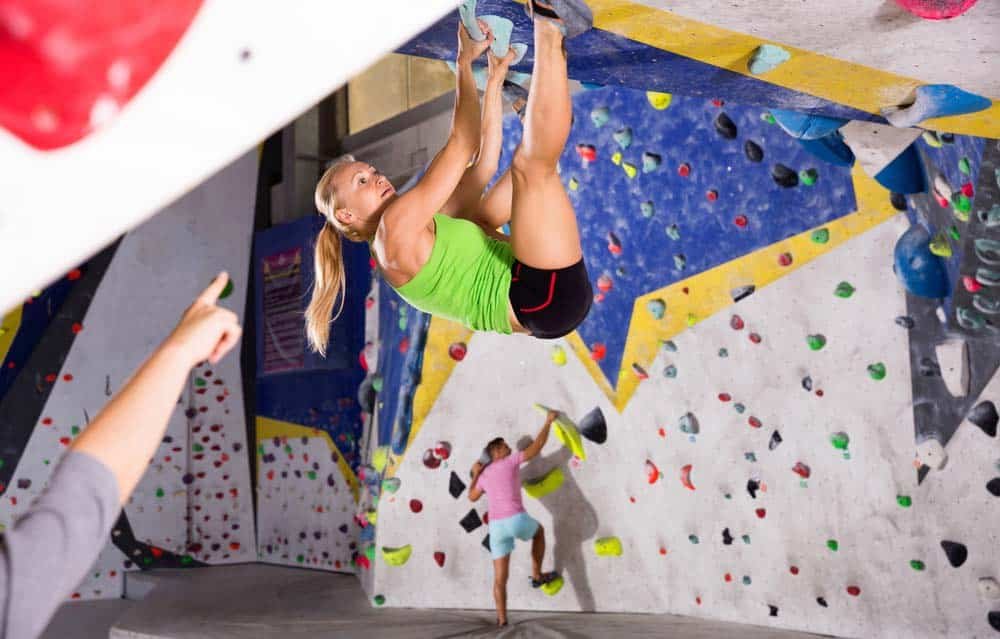
Bouldering is the perfect way to learn new techniques and refine your skills. That’s because it’s super simple to get a lot of repetition when bouldering. You don’t have to take turns with a partner or worry about any obstacles with roped climbing.
For example, if you want to improve your heel hooks, you can seek out boulders in the gym that incorporates heel hooking beta. You can even design your own boulders with the holds already on the wall to force yourself to practice heel hooks.
There’s Always Something New

One of the best parts about bouldering indoors is that there is always something new to learn or improve. Typically, climbing gyms reset boulder problems weekly. That means you’ll have a consistent flow of new boulder problems to challenge yourself.
That makes it easy to push yourself and progress through the bouldering grades.
You Build Strength Very Quickly
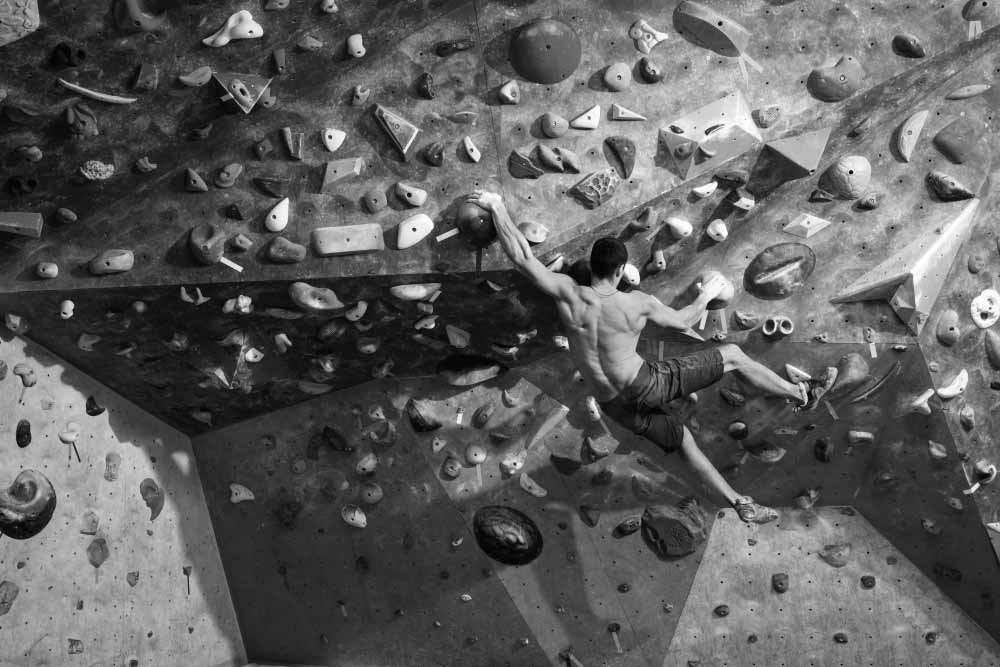
When you first start bouldering indoors, building strength very quickly is normal. That’s because you are learning something new and are highly motivated every day. During that process, your body adapts to the new activity and excels.
The positive reinforcement you receive from watching yourself improve and observing your gains in bouldering is super addicting. It helps boat your confidence and self-esteem and motivates you to keep climbing and improving.
Eventually, you may reach a plateau in your climbing– meaning you may realize that your progress has stagnated. If that becomes the case, normally a simple adjustment to your training regimen will help you return to observing improvements in your climbing.
Disadvantages of Bouldering Indoors

As I mentioned above, there are tons of climbers in the world who only practice bouldering. That’s because they love the sport’s simplicity and the climbing style. However, like with anything in life, if you only focus on one aspect of climbing, you may put yourself at a disadvantage regarding other aspects.
Regarding bouldering, there are two important disadvantages of the sport I’d like to mention.
Every Fall is a Ground Fall
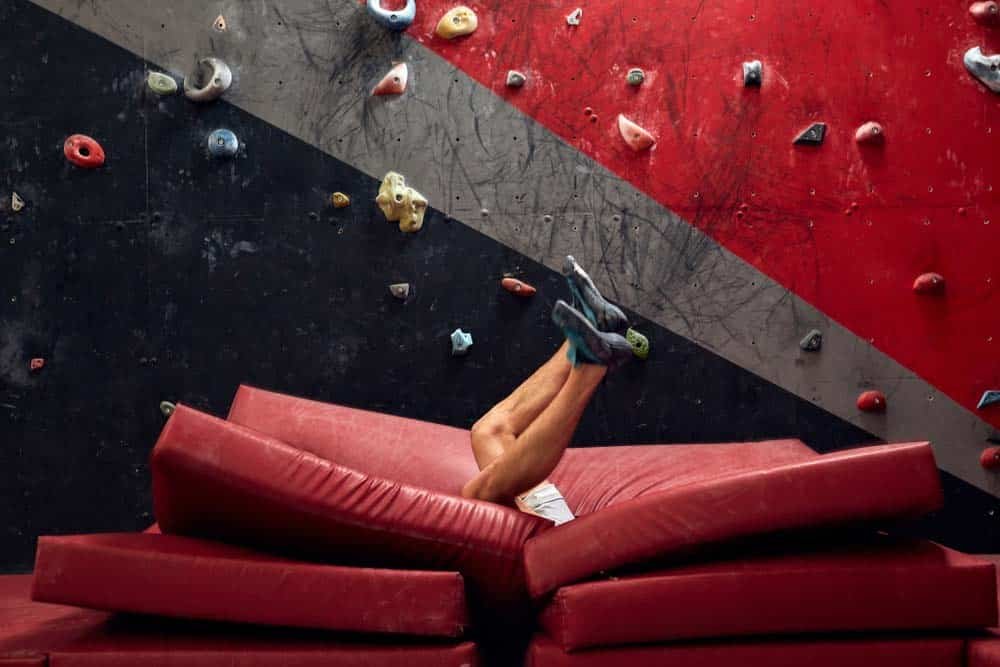
Bouldering does not require ropes and a belayer. Therefore, every time you fall, whether on purpose or on accident, your belayer will not catch you and hold you suspended in the air. Instead, you are going to hit the ground.
The fact that every fall is a ground fall in bouldering makes it one of the more dangerous climbing disciplines. Therefore, forming good habits early on regarding your decision-making while on the wall and learning to fall is critical.
You Can Develop a Lack of Endurance
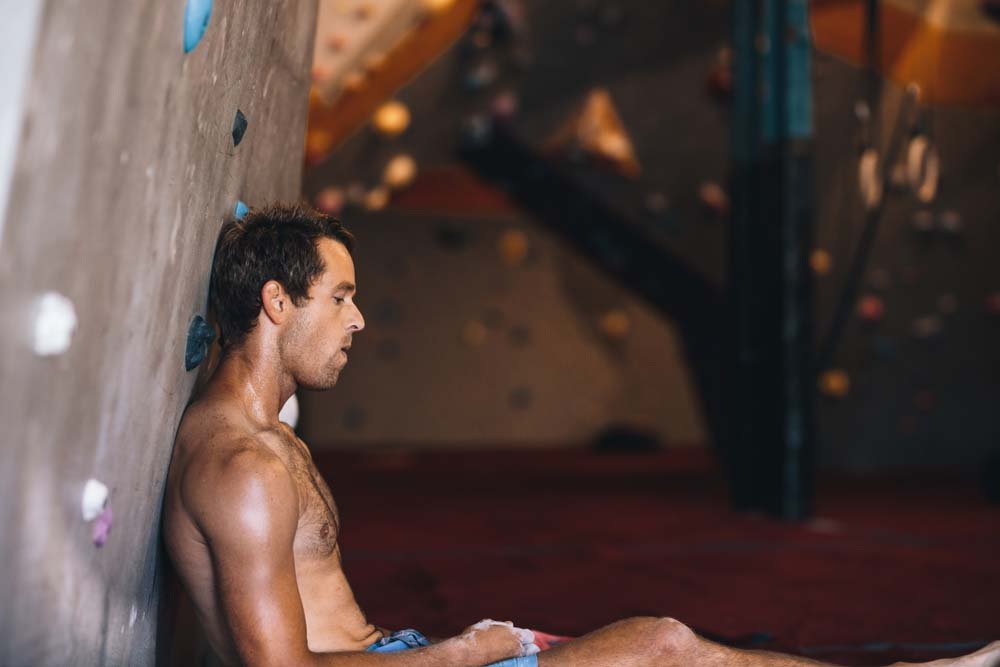
Most indoor bouldering walls are rarely taller than fifteen feet. And many of them are much shorter than that. The same goes for outdoor boulders.
Therefore, another disadvantage of bouldering is that you can develop a lack of endurance. That means that you feel strong and powerful for a few climbing sequences, but after a while, you get pumped and tired.
This puts you at a disadvantage if or when you transition to roped climbing and try routes taller than 15 feet.
Suggested Equipment for Bouldering Indoors

One of the reasons why learning to rock climb by beginning with bouldering makes so much sense is because bouldering indoors requires very little equipment. Therefore, the barrier to entry in terms of gear you need is more easily overcome compared to other climbing styles like sport climbing.
Here is a short list of the equipment I recommend you invest in if you want to start bouldering indoors.
- Rock climbing shoes: don’t have any? That’s okay– most climbing gyms have shoes you can rent.
- Chalk bag or bucket: chalk is super important, especially if you have sweaty hands because it helps dry them out and enhances the friction between your fingers and the holds.
- Climbing brush: the climbing holds on boulder problems in the gym can become greasy and hard to grip, so brushing holds can improve your chances of sending.
- Climbing tape: over time, you lose skin or get a flapper, so being able to tape your fingers is important.
How to Boulder Indoors Safely
Rock climbing is a dangerous sport– even indoors. Therefore it’s important to learn how to boulder indoors as safely as possible.
You’ll never be able to eliminate all the dangers of bouldering indoors, but if you consider the following tips, you can greatly mitigate certain risks that come with the territory.
Learn How to Fall

Falling off a boulder is a skill that needs to be learned. That’s because properly learning how to fall can mitigate the risk of injury from landing on the pads. And believe it or not, when you fall off a boulder accidentally or jump off purposely, you don’t need to land on two feet like an Olympic gymnast.
It’s actually the opposite. Here are the steps for a proper falling technique while bouldering.
- To the best of your ability, land on two feet.
- Upon landing, carry your momentum backward and continue falling onto your butt.
- After landing on your butt, continue carrying your momentum and roll onto your back.
- During the entire falling process, bring your arms into your chest and avoid trying to brace your fall with your hands.
The proper falling technique reduces the impact your body feels from falling and helps prevent injuries like twisted ankles and knee joints, strained backs, broken wrists, and hyper-extended elbows.
Downclimb Boulders
If you are still learning how to fall properly or are scared of falling, the best thing you can do is downclimb. Downclimbing is the act of reversing the move you made to climb upwards so you can descend downwards.
You can downclimb until your feet touch the ground or until you are at a height that is safer for you to let go and land properly.
Plus, an added benefit of downclimbing, besides mitigating the risk of injury from falling, is that you get to build up your endurance.
Read the Route from the Ground

Blindly pulling onto a boulder is a good way to climb yourself into an uncomfortable and possibly unsafe position.
Instead, read the route from the ground to the best of your ability so you know what to expect when climbing. By reading the route from the ground, you can look for crux sections that may make you fall and be able to plan your landing zone ahead of time.
Pay Attention to Where You Walk and Stand
Contrary to popular belief–bouldering gyms are not safe places. That’s because there are human-sized overhead hazards, typically between 100 and 200 pounds, falling from the tops of walls all around you.
To put it less facetiously– the risk of injury from another climber falling and landing on top of you should not be taken lightly. Therefore, paying close attention to where you walk and stand while bouldering is critical.
Always pay attention to fall zones and never walk or climb below another climber. For example, when you are waiting for a climb, pay attention to nearby climbers and where their limbs might swing during a dyno, how they might fall, or where they might land.
In addition, unless another climber directly asks you to provide a spot, you should not put yourself in danger by spotting. Typically, it’s better to let the climber fall to the pads with proper falling technique.
How to Start Bouldering Indoors

Learning to boulder indoors can feel intimidating, especially when it seems like everyone around you has more experience. So if you are new to bouldering indoors, here are some general guidelines.
Wait Your Turn
Climbing gyms can become busy with climbers. During busy times, waiting your turn before trying a boulder may be necessary.
If that is the case, just look around the nearby area to see if anyone else wants to try the boulder you want to climb. If a short line of climbers want to work on the same boulder as you, just be communicative and patiently wait your turn.
Give People Space

Sometimes bouldering routes overlap on the wall. If that is the case, try not to pull onto your boulder while someone else is on the wall. That’s because climbing too close to another climber is impolite and unsafe.
But feel free to climb if your boulder is next to another climber already on the wall and does not overlap or have the same fall zone.
Avoid Spraying Unsolicited Beta

Spraying unsolicited beta is the act of giving another climber advice that they did not ask for. In bouldering, spraying beta is considered impolite because, typically, climbers want to find the solution to the boulder problem themselves.
Plus, there may be multiple ways to solve a boulder problem. Therefore, your beta may be unnecessary or more difficult for another climber.
However, if someone asks you for a tip, it’s okay to provide your advice and collaborate with them to solve the boulder.
Keep Your Shirt On

Considering what to wear bouldering? Well, this one is mainly for the guys. Depending on your gym’s rules and the local climbing culture, it may be acceptable for male climbers to climb with their shirts off.
However, you should avoid taking your shirt off. Guys being able to take their shirts off is a strange double standard that can make other people uncomfortable and is unsanitary.
Don’t Grease Up the Holds
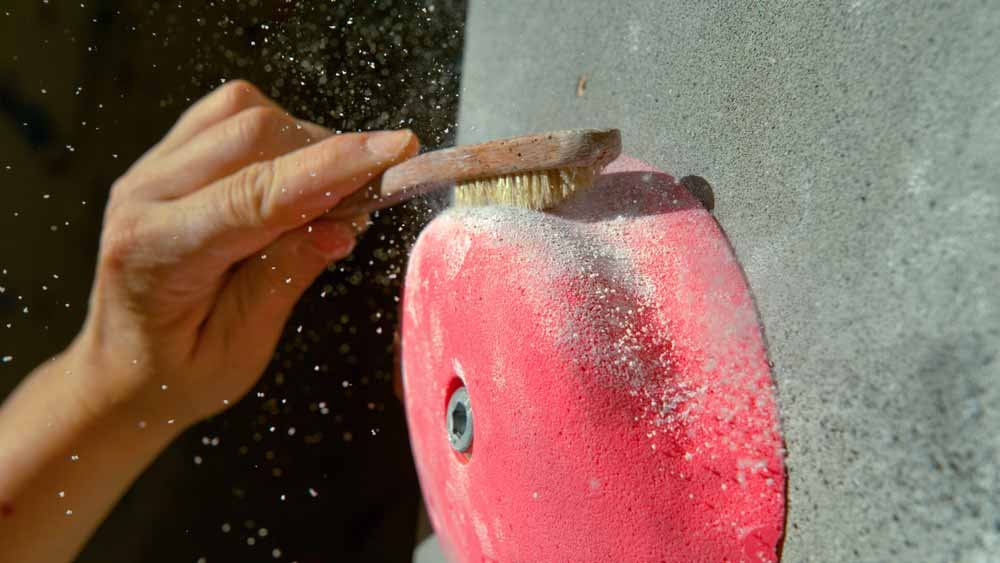
If you notice someone brushing all the holds on a boulder problem, don’t jump on the climb and grease up the grips. Climbing a boulder that has been freshly brushed is impolite and should be avoided.
That’s because when someone brushes the holds on a climb, that typically signals that they are actively working the boulder and cleaning it for themselves.
So if you want to try the boulder, wait your turn or ask if it’s okay to try it with them. If you send it and are ready to move on to something else, it’s polite to brush the holds after you are done so that the person can continue trying.
Final Thoughts on Bouldering Indoors
In terms of getting started rock climbing, bouldering is one of the simplest ways to learn how to climb and fall in love with the sport. However, just because bouldering is simple does not mean it’s not complex and challenging. In fact, it’s quite the opposite– bouldering is a highly complex style of climbing that requires a lot of full-body strength and climbing techniques.
Because of that, bouldering is the ideal way to learn how to climb. Learning to boulder indoors will help you build a solid foundation of climbing experience, technique, and strength, allowing you to develop into a better climber, no matter what style you prefer.



